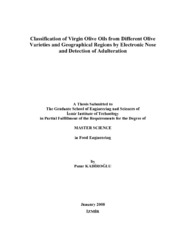Please use this identifier to cite or link to this item:
https://hdl.handle.net/11147/3945Full metadata record
| DC Field | Value | Language |
|---|---|---|
| dc.contributor.advisor | Korel, Figen | - |
| dc.contributor.author | Kadiroğlu, Pınar | - |
| dc.date.accessioned | 2014-07-22T13:52:48Z | - |
| dc.date.available | 2014-07-22T13:52:48Z | - |
| dc.date.issued | 2008 | - |
| dc.identifier.uri | http://hdl.handle.net/11147/3945 | - |
| dc.description | Thesis (Master)--Izmir Institute of Technology, Food Engineering, Izmir, 2008 | en_US |
| dc.description | Includes bibliographical references (leaves: 80-87) | en_US |
| dc.description | Text in English; Abstract: Turkish and English | en_US |
| dc.description | xv, 93 leaves | en_US |
| dc.description.abstract | Extra virgin olive oils produced from fresh and healthy olive fruits have a delicate and unique flavor that makes them highly appreciated by consumers. Their taste and aroma are closely related to volatile and non-volatile compounds and determined by chromatographic and sensory analyses. However, these methods are expensive and time consuming to be used routinely in food industry. Electronic nose that can mimic the human sense of smell and provide low-cost and rapid sensory information is a new approach allowing the discrimination of aroma fingerprints of oils. In this study, the aroma fingerprints of Turkish extra virgin olive oils produced from various olive varieties (Ayvalık, Gemlik, Memecik, Erkence, Domat and Nizip) and Ayvalık and Gemlik olive varieties growing in two different regions of West Turkey (İzmir and Edremit) and the commercial extra virgin olive oils obtained from Tariş Olive and Olive Oil Agricultural Sales Cooperatives Union during two consecutive harvest years were determined by an electronic nose. In addition, the electronic nose was proposed for the detection of adulteration of these oils with monovarietal olive oils and with other edible oils such as sunflower, corn, soybean and hazelnut oils. The data were analyzed using chemometric methods by soft independent modeling of class analogy (SIMCA) software. As a conclusion, it was found that the electronic nose could provide good separation on some of the varieties and geographical regions. The electronic nose has been able to differentiate adulterated and non-adulterated extra virgin olive oils at higher than 10 % adulteration level successfully. | en_US |
| dc.language.iso | en | en_US |
| dc.publisher | Izmir Institute of Technology | en_US |
| dc.rights | info:eu-repo/semantics/openAccess | en_US |
| dc.subject.lcc | TP683 .K115 2008 | en |
| dc.subject.lcsh | Olive oil--Analysis | en |
| dc.subject.lcsh | Chemical dedectors | en |
| dc.subject.lcsh | Odors | en |
| dc.subject.lcsh | Olfoctometry | en |
| dc.title | Classification of Virgin Olive Oils From Different Olive Varieties and Geographical Regions by Electronic Nose and Detection of Adulteration | en_US |
| dc.type | Master Thesis | en_US |
| dc.institutionauthor | Kadiroğlu, Pınar | - |
| dc.department | Thesis (Master)--İzmir Institute of Technology, Food Engineering | en_US |
| dc.relation.publicationcategory | Tez | en_US |
| dc.identifier.wosquality | N/A | - |
| dc.identifier.scopusquality | N/A | - |
| item.openairecristype | http://purl.org/coar/resource_type/c_18cf | - |
| item.languageiso639-1 | en | - |
| item.openairetype | Master Thesis | - |
| item.grantfulltext | open | - |
| item.fulltext | With Fulltext | - |
| item.cerifentitytype | Publications | - |
| Appears in Collections: | Master Degree / Yüksek Lisans Tezleri | |
Files in This Item:
| File | Description | Size | Format | |
|---|---|---|---|---|
| T000736.pdf | MasterThesis | 1.15 MB | Adobe PDF |  View/Open |
CORE Recommender
Page view(s)
320
checked on Mar 31, 2025
Download(s)
102
checked on Mar 31, 2025
Google ScholarTM
Check
Items in GCRIS Repository are protected by copyright, with all rights reserved, unless otherwise indicated.